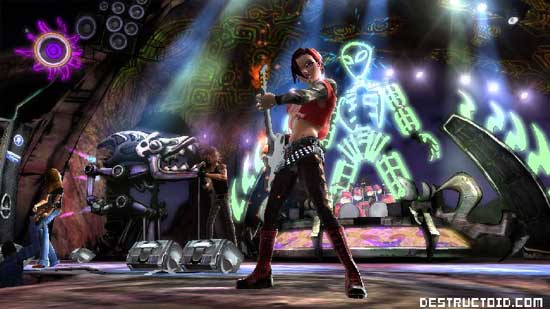I’ve been torn on Guitar Hero III: Legends of Rock.
On one hand, it’s the third installment of one of my favorite rhythm-based games of all time (which is, by the way, a very small list). On the other hand, it’s in the care of a new developer, Neversoft, which had to essentially recreate the Guitar Hero engine from scratch (which they lost when Harmonix snuck out in the middle of the night with Electronic Arts), and word of guitar battle modes with power-ups and special attacks had me more than a little confused and doubtful.
Luckily, my hands-on time with the game has eased many of my worries. Hit the jump for my quick impressions based on my short time with Guitar Hero III: Legends of Rock‘s new Battle Mode.
When I spotted Guitar Hero III in the Barker Hangar, I pounced on it like it baby kitten. Excited to get started, I dove right into the game’s Face Off mode and promptly chose Muse’s “Knights of Cydonia,” a song which I thought would actually be fun to play. As it turns out, not so much.
Face Off mode is essentially identical to what players are familiar with — each player trades licks, and whomever has the highest score wins. Simple, and more to the point, the way I like it. The problem with my first impressions of the game happened to be the choice of song.
I like Muse — their over-the-top, Radiohead-meets-Queen style of rock should lend itself well to the game. However, the note pattern, surprisingly, didn’t lend itself well to the game. On top of that, the game I was playing felt exactly like previous iterations of the game. Not a bad thing necessarily, but taken in the context of the current playing field (read: Rock Band), there was nothing exciting about the game.
Then I was shown the game’s new Battle Mode, a head-to-head competition featuring wacky ideas like power-ups and special attacks, and the game really opened up. In Battle Mode, certain notes will be surrounded by spikes — clear a section of the spiked notes and you’ll receive a random power-up. For instance, one power-up, Amp Overload, will cause your opponent’s note patterns to appear blurry or disappear altogether. Others like Double Notes or Lefty Flip will screw with your opponent in other ways.
Tiff and I went head to head on Living Colour’s “Cult of Personality” (which was actually re-recorded by the band for the new game — who knew those guys were even still together?), and I found myself on the short end of a “Broken String” power-up stick. At that point, one of my notes was “broken,” and I had to repeatedly tap said note before I could use it.
In theory, all of this sounds like it might be a bit too much, taking the wonderful simplicity of the Guitar Hero formula and complicating it in ways that should be avoided. In practice, however, these kind of things actually add quite an unpredictable, frantic feel to the gameplay. Even though I still owned Tiff and made her cry, these power-ups definitely help to further level the playing field in head-to-head competitions.
Another thing of note is the game’s art style. Neversoft’s in-house art team designed the characters from scratch, and even though many of them are based on existing Guitar Hero favorites, the style shift is quite dramatic. Environments and player models take on a darker, edgier tone, which is not necessarily a bad thing. Was anyone playing the game for its graphics anyway?
While I’m not convinced that the game’s new additions will help it stay out of shade of the gigantic new kid on the block, Rock Band, the solid game play remains. And hell, the name alone will help it sell like hot cakes when it ships this fall for the PlayStation 2, PlayStation 3, Xbox 360, and the Nintendo Wii.


